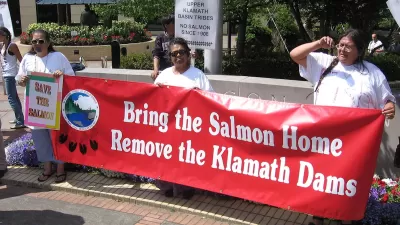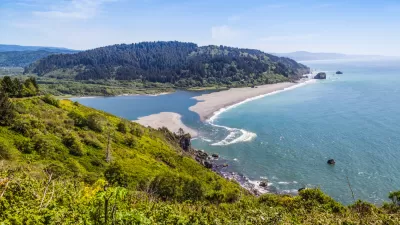This feature from Miller-McCune looks at the debate over a dam near Stanford University, and whether it should be removed to restore the ecosystem the area once housed, or maintained to protect the ecosystem that it spawned.
"'There's no other species like the steelhead that connects the mountaintops to the faraway oceans like they do,' notes Stoecker.
That critical connection was severed in October 1891, when the Spring Valley Water Company, hungry for business and thirsty for water for the rapidly expanding city of San Francisco, flooded the once thriving wetlands and blocked the tight canyon at its base with an impenetrable concrete wall. The reservoir behind this wall, Stoecker says, has become an "artificial and unsustainable ecosystem" in which exotic large-mouth bass and bullfrogs prey voraciously on native species. He understands now that the trout he caught as a child were the tattered ancestors of those fish that once swam free in the ocean and spawned in the creeks above Searsville Dam - stranded now for more than 100 years. Fueled by such painful truths, Stoecker tells a story in which Searsville Dam plays the part of a villain who must be toppled in order to mend the bonds that have been broken."
One side argues that the dam has cut off the natural livelihood of steelhead trout in the area, but opponents of dam removal say the structure has created a vibrant bird habitat that would be destroyed along with the dam.
FULL STORY: Diving Deeper into Searsville

Planetizen Federal Action Tracker
A weekly monitor of how Trump’s orders and actions are impacting planners and planning in America.

Congressman Proposes Bill to Rename DC Metro “Trump Train”
The Make Autorail Great Again Act would withhold federal funding to the system until the Washington Metropolitan Area Transit Authority (WMATA), rebrands as the Washington Metropolitan Authority for Greater Access (WMAGA).

The Simple Legislative Tool Transforming Vacant Downtowns
In California, Michigan and Georgia, an easy win is bringing dollars — and delight — back to city centers.

The States Losing Rural Delivery Rooms at an Alarming Pace
In some states, as few as 9% of rural hospitals still deliver babies. As a result, rising pre-term births, no adequate pre-term care and "harrowing" close calls are a growing reality.

The Small South Asian Republic Going all in on EVs
Thanks to one simple policy change less than five years ago, 65% of new cars in this Himalayan country are now electric.

DC Backpedals on Bike Lane Protection, Swaps Barriers for Paint
Citing aesthetic concerns, the city is removing the concrete barriers and flexposts that once separated Arizona Avenue cyclists from motor vehicles.
Urban Design for Planners 1: Software Tools
This six-course series explores essential urban design concepts using open source software and equips planners with the tools they need to participate fully in the urban design process.
Planning for Universal Design
Learn the tools for implementing Universal Design in planning regulations.
Smith Gee Studio
City of Charlotte
City of Camden Redevelopment Agency
City of Astoria
Transportation Research & Education Center (TREC) at Portland State University
US High Speed Rail Association
City of Camden Redevelopment Agency
Municipality of Princeton (NJ)





























